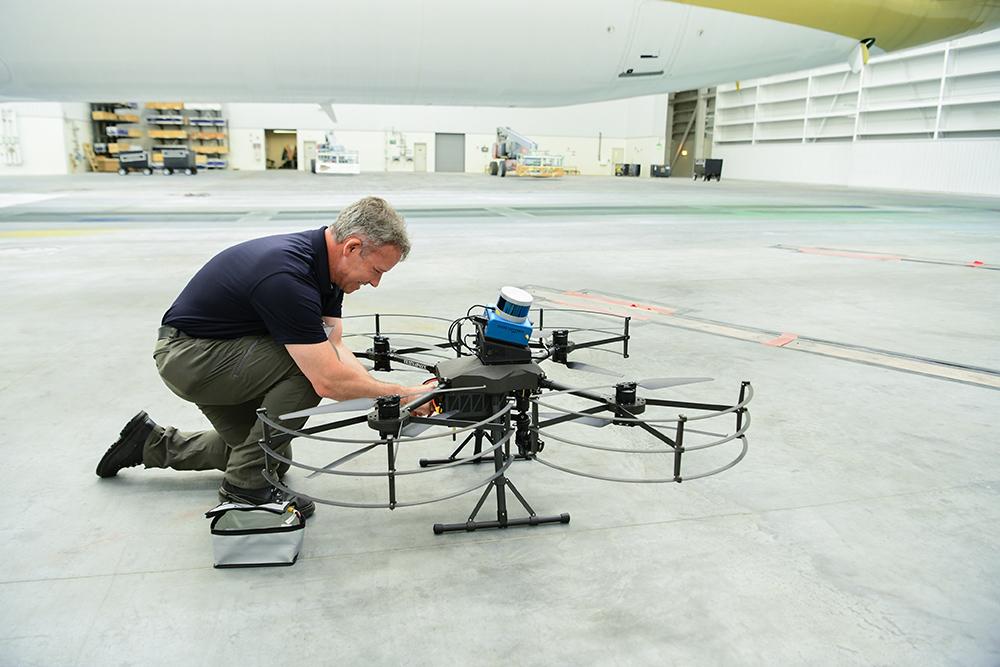Drone Inspection Provider Eyes Commercial, Defense MRO Applications

Another technology provider is joining the movement to perform drone inspections of aircraft. Near Earth Autonomy, founded by Carnegie Mellon University staff, is developing drones that could be used for both military and commercial aircraft—a potential advantage for MROs that perform both civil and defense work, according to Alli Locher, senior product manager of Near Earth’s inspection group.
Near Earth’s equipment has been certified to meet requirements of the National Defense Authorization Act (NDAA), basically ensuring components have been made in the U.S. or U.S.-friendly countries. NDAA compliance is necessary to work on U.S. defense aircraft, and Locher says no other current drone offer meets these requirements.
In Europe, several other drone-based initiatives are focusing on inspections of defense aircraft. For example, French startup Donecle is working with Dassault Aviation and the French Armed Forces for drone-based inspections of Rafale aircraft, and the UK Royal Air Force is testing multicopter drones for inspections of its fleet.
Since 2021, Near Earth has been working with Boeing Global Services to use drones and a 5G network to inspect military aircraft. The project began with research in 2017 on the potential of drones to inspect C-17 Globemasters, at which time Boeing invested in the young company.
However, Locher says Near Earth will offer drones for commercial aircraft as well. She believes the drones would be especially useful for unscheduled safety checks, such as after a hail or lightning strike, when hangar space might not be available, unlike for a scheduled C check.
Military inspections, she notes, must sometimes be performed outside because hangars are in high demand, and Near Earth can work both outside and inside a wide variety of hangars.
Boeing and Near Earth kicked off a beta test of drone inspections of military aircraft on May 1. Locher is hoping for a similar beta test of Near Earth’s drones with an airline in 2024.
Locher does not see “a ton of value” in discretionary drone inspections, such as inspections of aircraft paint jobs. She believes the real value will be in safety-related inspections required by regulators, which require proving the equivalency of drone inspections and manual inspections and thus becoming an option in a major OEM’s aircraft maintenance manual (AMM).
Acceptance for safety-related inspections can be a lengthy process. Donecle says it is the only drone provider accepted by the FAA and European Union Aviation Safety Agency in an AMM, for Airbus A320-family aircraft. No other drone provider contacted by Aviation Week disputed that claim.
Near Earth has been working with four of its drones on widebody commercial aircraft such as the Boeing 777 and 787. One of the company’s drones can complete a general visual inspection of the upper sections of a widebody in about an hour, with other inspection times varying by type of inspection requested. Generally, Locher says, drone inspections take about half the time required—or even less—for manual inspections.
The drones can also inspect lower sections of aircraft, but Locher says their real advantage is in inspecting upper stabilizers, wing and fuselage tops where lifts and harnesses would be required for technician safety during manual inspections.
Only one technician is required to operate the drone, although a second safety technician has been used in tests so far. The drone conducts inspections according to task cards and a standard flight plan for the relevant aircraft type. For a general visual inspection of a 787, the drone takes about 50 high-resolution pictures, each tied to the computer-aided design model of the aircraft. It can adjust images in number and detail depending on the type of inspection.
Although Near Earth does have defect suggestion software, its approach is to offer engineers a limited number of high-quality images to examine themselves. Until artificial intelligence develops the capability to really identify all defects in different conditions of light and shadow, Locher says she would not trust a completely automated inspection approach.
However, manual viewing of autonomously-taken pictures requires limiting the number of photos for practicality. Some drone competitors generate thousands of images, Locher says.
Near Earth drones are not physically tethered, but operate with layers of virtual control, including geo-fencing.
Locher says the special advantages of Near Earth drones are their dual capability for both military and commercial uses, proven and repeatable flight plans and production of fewer, high-quality images. She sees no advantage in a swarm of drones, as proposed by Korean Air, unless “there’s a huge hail event.”





